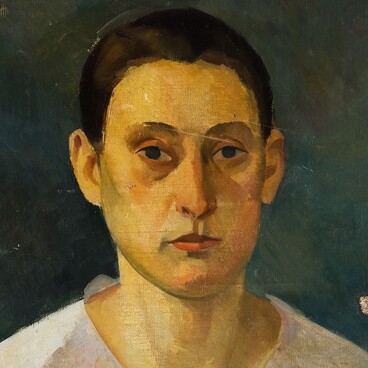The painting ‘Ural Plant’ was created by Alexander Labas, a Soviet painter of the Russian avant-garde art movement of the 1920s–1930s. It is known that he depicted the inside of a metallurgical plant. However, he did not specify the type of production in his painting but rather showed a generalized poetic image of the plant.
In the early 1920s, Labas lived in Yekaterinburg, where he taught at Vkhutemas and participated in local exhibitions. The ‘Ural Plant’ was painted in 1925 when Alexander Labas had already left the city. Therefore, it is safe to say that the painting was created by memory, and the artist turned to the modern ubiquitous theme of industrialization and technology.
The canvas was first presented in May 1926, at the second exhibition of the Society of Easel Painters (OST) in Moscow. OST stands for the Society of Easel Painters, an art group consisting of painters who aimed to challenge a deep prejudice against easel paintings. ‘Easel’ means executed on an easel and refers to common paintings that are intended to be displayed framed and hanging on a wall (as opposed to monumental paintings, created directly on walls or as a part of an architectural complex).
In the early 20th century, some painters came to the conclusion that easel painting was no longer necessary. It was believed that an art movement, that would serve the industrialization, was far more suitable for the modern world, which required designing household objects, fabrics, furniture, and new architectural forms instead of ‘useless’ paintings. This approach outraged art lovers and caused other artists to form various groups.
Alexander Labas was one of the founding members of the OST. The OST painters were called ‘ostovtsy’ and they glorified Soviet reality by depicting the construction of new neighborhoods and crossroads, various sports achievements, and factory routine. However, they still used the techniques they adopted from constructivism and German expressionism — sharp perspectives, bright expressive lines, and dynamic elements. They believed that such artistic language fully rendered the astounding pace of the USSR’s development.
Unfortunately, Alexander Labas’ focus on the visual aspects of paintings led to his being accused of formalism in the 1930s. After that, the orders stopped coming, so the only way he could earn his living was to paint panoramas and dioramas to be exhibited outside the USSR. Sometimes Labas would have to choose between buying food or new paints. Despite all that, he never gave up easel painting, and at the end of the 1960s, he became a recognized painter once more. His paintings were liked by many, including the famous Soviet film director Andrey Tarkovsky. Nowadays, Labas’ works are in demand in Russia, as well as beyond.
In the early 1920s, Labas lived in Yekaterinburg, where he taught at Vkhutemas and participated in local exhibitions. The ‘Ural Plant’ was painted in 1925 when Alexander Labas had already left the city. Therefore, it is safe to say that the painting was created by memory, and the artist turned to the modern ubiquitous theme of industrialization and technology.
The canvas was first presented in May 1926, at the second exhibition of the Society of Easel Painters (OST) in Moscow. OST stands for the Society of Easel Painters, an art group consisting of painters who aimed to challenge a deep prejudice against easel paintings. ‘Easel’ means executed on an easel and refers to common paintings that are intended to be displayed framed and hanging on a wall (as opposed to monumental paintings, created directly on walls or as a part of an architectural complex).
In the early 20th century, some painters came to the conclusion that easel painting was no longer necessary. It was believed that an art movement, that would serve the industrialization, was far more suitable for the modern world, which required designing household objects, fabrics, furniture, and new architectural forms instead of ‘useless’ paintings. This approach outraged art lovers and caused other artists to form various groups.
Alexander Labas was one of the founding members of the OST. The OST painters were called ‘ostovtsy’ and they glorified Soviet reality by depicting the construction of new neighborhoods and crossroads, various sports achievements, and factory routine. However, they still used the techniques they adopted from constructivism and German expressionism — sharp perspectives, bright expressive lines, and dynamic elements. They believed that such artistic language fully rendered the astounding pace of the USSR’s development.
Unfortunately, Alexander Labas’ focus on the visual aspects of paintings led to his being accused of formalism in the 1930s. After that, the orders stopped coming, so the only way he could earn his living was to paint panoramas and dioramas to be exhibited outside the USSR. Sometimes Labas would have to choose between buying food or new paints. Despite all that, he never gave up easel painting, and at the end of the 1960s, he became a recognized painter once more. His paintings were liked by many, including the famous Soviet film director Andrey Tarkovsky. Nowadays, Labas’ works are in demand in Russia, as well as beyond.




